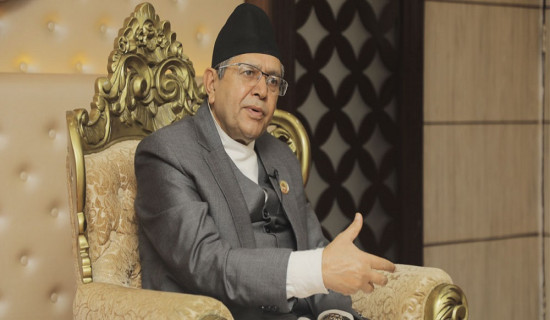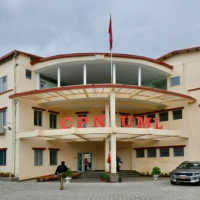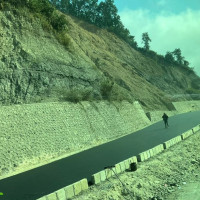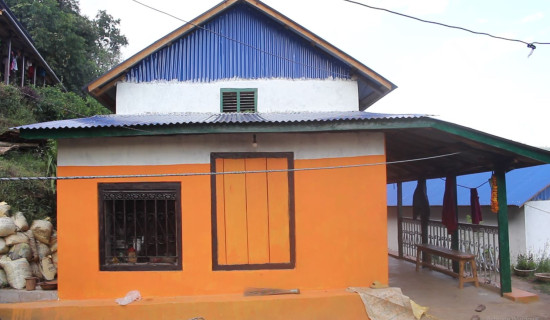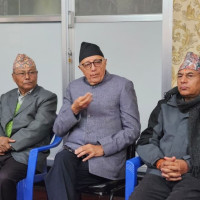- Sunday, 14 December 2025
Gharial number growing in BNP
Bardiya, July 18: Natural hatching and nesting of critically endangered Gharial (Gavialis gangeticus) in the Geruwa River inside the Bardiya National Park (BNP) area has been a sign of relief for conservationists, trying every year to increase the number of individuals in the natural habitat.
The Geruwa River, a branch of Karnali River, inhabits the rare species gharial with 28 babies after almost two decades.
Locals spotted the female Gharial with babies one month ago on the bank of the river, in the Thakurdwara Municipality area. It is located a few kilometers downstream from Chisapani and the river flows through the BNP.
Nesting in the natural habitat in the area after almost two decades has shown a sign of relief and a successful conservation drive in protecting critically engendered species inside the BNP, said the chief conservation officer at BNP Bishnu Prasad Shrestha.
The gharial is known for its unique body structure. They have extremely long and narrow snouts covered with smooth, non-overlapping scales.
A nature guide, Manju Mahatara of Thakurdwara Municipality, said the gharial was spotted even last year but it disappeared later. But this time a few months ago an adult gharial was spotted at the same location. “We became happy after seeing the rare species here and we told everyone not to go nearby,” she said.
Even though we asked them not to go there, people used to go nearby to take photos, and children used to play in the area but a few weeks later, the gharial started showing strange behaviour. “After some time, we saw a number of babies basking in the sun riding their mother piggyback.” It was on June 15, she said.
We did not see the male in the area so we believed that the female gharial may have mated downstream in Katarniaghat Wildlife Sanctuary in India and came here crossing the border to lay her eggs.
The Gharial is one of the largest members of the crocodile family. It looks very similar to crocodiles and alligators. It is considered critically endangered on the IUCN Red List and found only in the rivers of Nepal and India.
According to Shrestha, the nesting of gharial in the Geruwa River is a sign that the critically endangered species is on the road to recovery. They need fresh water and eat only fish. “Earlier, the river used to remain waterless during the dry season and there was no possibility for gharials to remain in the dry channel. Now for the last two years, we are working to flow water in the Geruwa River regularly after channelising in the Lalmati area, so the area becomes suitable for gharials where they can get enough fish for their food.
The gharial is an indicator species of healthy freshwater ecosystems and is one of the protected reptiles of Nepal under Schedule I of the National Parks and Wildlife Conservation Act, 1973, he informed. Gharial conservation is challenging as the species’ survival rate in the natural habitat is very low.
According to Gharial Conservation Action Plan for Nepal (2018-2022), dams and barrages, mining, floods, and pollution have always been major sources of threat to gharial conservation.
Habitat loss and degradation, and reduction of prey (fish) are other threats to gharial in the country. Being a freshwater species, the climate-induced impact can be a possible threat to this species as it might have a direct impact on water resources. However, with the increasing estimated number of gharial from 102 in 2011 to 198 in 2016, there are hopes and enthusiasm for conserving this endangered species, according to the Action Plan. The current population of gharials is estimated to be around 90 adults.
According to Shrestha, 20 gharial adults with 50 babies hatched this year have been inhabiting the Babai River that flows through the BNP.
The BNP itself has a gharial breeding centre inside the park, where 12 adult gharials, two of them males, are kept. There are currently 50 babies nesting inside the breeding centre whereas the centre is planning to release 35 gharials aged five years into nature soon.
The centre was established in BNP in 1982 and began breeding with 25 eggs collected from the Babai River.



